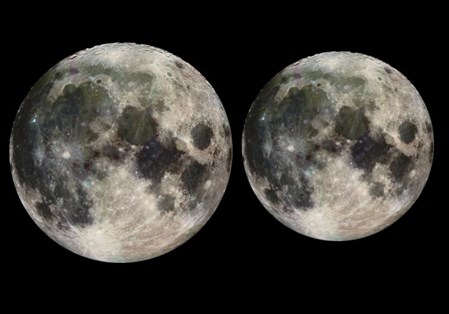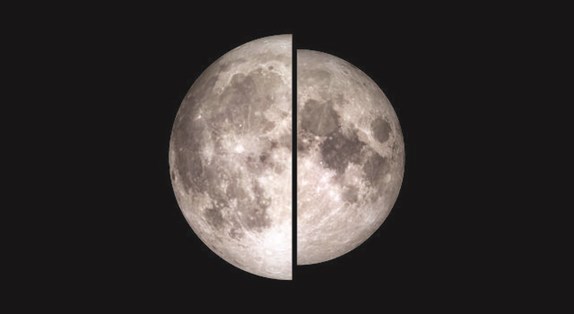Skynotes: May 2020
Full Moons: Micro and super
Last month’s supermoon was a great sight, so big and bright. But if you missed it, or would like to marvel again, then there’s another on May 7.
The moon’s entire hemisphere as seen from earth will again be totally lit by the sun as our lunar companion moves to the side opposite to the sun for May’s full moon. A supermoon will be closer than usual making it appear 7% larger and 15% brighter than an average full moon.
In fact, two factors work together to give us full moons and supermoons; the shape and the angle of the moon’s orbit. The shape is elliptical which brings it closer and then further during its 28-day orbit. The average earth-moon distance is 384,000 km but varies by about 50,000 km from closest (perigee) to furthest (apogee). The other factor, the angle of its orbit, is tilted a little over 5 degrees in relation to earth’s orbital plane or path around the sun. These two combine to give us full or super moons because our planet almost always never ‘gets in the way’ of sunlight fully illuminating the moon.
There are, however, two exceptions. One is a lunar eclipse when the moon crosses earth’s orbital plane and, over several hours, passes through earth’s shadow. The moon is then dimly lit by sunlight that bends (refracts) through our atmosphere losing its blue wavelengths in the process. We therefore see a reddened, or copper blood moon.
The second exception is the much rarer solar eclipse when the moon crosses our planet’s orbit on our sunward side. This spectacularly blocks the sun for a few short minutes during which no sunlight can reach the side of the moon facing earth and so we cannot see our lunar companion, although we are awestruck at the extraordinary event.
Find out more
Planetarium
While the Melbourne Planetarium and all Museums Victoria venues are closed, our websites are full of interesting content. Explore our astronomy factsheets and education pages as we continue to add exciting new material for our web visitors to learn from and enjoy.
Melbourne sun times
| Date | Rise / Solar noon* / Set (day length) |
|---|---|
| Fri 1st | 7.01am / 12.17pm / 5.32pm (10.31 hrs) |
| Mon 11th | 7.10am / 12.16pm / 5.22pm (10.12 hrs) |
| Thu 21st | 7.18am / 12.16pm / 5.14pm (9.56 hrs) |
| Sun 31st | 7.25am / 12.17pm / 5.09pm (9.43 hrs) |
*When the Sun is at its highest crossing the meridian or local longitude.
Moon phases
| Phase | Date |
|---|---|
| First Quarter | Fri 1st |
| Full Moon | Thu 7th |
| Third Quarter | Fri 15th |
| New Moon | Sat 23rd |
| First Quarter | Sat 30th |
This month’s Moon perigee (closest to Earth) is on Wed 6th at 356,654 km and apogee (furthest from Earth) is on Mon 18th at 405,583 km.
Planets
Mercury, is in the evening in the west from late May into early June.
Venus is also a western evening object visible from 6pm. It will be close to Mercury on the 22nd but by the end of the month it will be too close to the sun to be seen.
Mars gets brighter during May rising at midnight and visible in the east until morning.
Jupiter rises a couple of hours before midnight and will be easily seen until dawn shining as the 3rd brightest night-time object after the Moon and Venus.
Saturn will rise about an hour after Jupiter and should be seen all night until morning. In dark skies you may see its yellow tinge, and in a modest telescope its beautiful rings.
Meteors
The Eta Aquarids meteor shower begins on the 3rd peaking on the 6th. The shower is linked to Comet Halley and rates can reach 55 meteors per hour. They are sand or rice grain size, very fast at 64km/sec, usually yellow with persistent trains, and enter the atmosphere 100km above the surface. They appear in the constellation Aquarius, and the radiant, or point from which they appear to originate, rises at 2.30am moving higher to the north-east by dawn.
Stars and constellations
The constellation of Scorpius can be seen rising in the south-east. The scorpion's heart is marked by the red star Antares. This is a very rich area of the Milky Way and the scorpion's tail contains beautiful star clusters that can be seen with binoculars.
The brightest star in the night sky, Sirius, is high in the west. Lying above and to the south of Sirius is Canopus, the second brightest star in the night sky. Canopus belongs to the constellation Carina (the keel).
In the north is the constellation of Leo, the lion. Leo is upside down compared to the northern hemisphere. Look for an upside-down question mark as his head and mane. The brightest star in Leo is Regulus, meaning ‘little king’.
All these have meaning and significance from a long and rich tradition of aboriginal night sky observing. In the Boorong tradition of north-west Victoria, the star Sirius is the head of Warepil the wedge-tailed eagle, with less bright stars above and below marking wings. Find out more about our First People’s night sky at:
International Space Station
ISS orbits every 90 minutes at an average distance of 400 km appearing like a bright star moving slowly across the night sky. Here are some of the brightest passes expected this month over Melbourne and Central Victoria:
Thursday 7th 6:57pm-7:00pm South-West to South-South-East
Sunday 10th 6:11pm-6:17pm South-West to North-East
Saturday 23rd 6:07am-6:14am North-West to South-East (morning)
For predictions go to:
On this day
1st 1958, Van Allen radiation belts were discovered - concentrations of electrically charged particles surrounding the Earth influenced by its magnetic field.
1st 1930, Pluto’s name is confirmed by Lowell Observatory after a suggestion by British 11-year old Venetia Burney.
1st 1910, birth of astrophysicist J Allen Hynek who investigated reports of unidentified flying objects for the US Air Force under ‘Project Blue Book’.
4th 1675, Royal Greenwich Observatory is established by decree of King Charles II.
5th 1961, Alan Shepard Jr (Mercury 3), the first American to be launched into space.
7th 1992, the Space Shuttle Endeavour (USA) blasts off on its maiden voyage. It was the 47th shuttle mission.
9th 1979, Pioneer Venus 2 craft sent five probes into the atmosphere of Venus.
11th 1916, Albert Einstein’s ‘General Theory of Relativity’ was first presented.
12th 1965, Luna 5 (USSR) crashes on Moon.
13th 1861, one of eight 19th century ‘Great Comets’ is discovered by John Tebbut.
14th 1973, Skylab 1, USA’s first space station was launched.
15th 1618, the Third Law of Planetary Motion, establishing a direct relationship between distance from Sun and orbital period, is determined by Johannes Kepler.
16th 2011, Space Shuttle Endeavour (USA) launched on its 25th and final mission.
17th 1969, Venera 6 (USSR) sends data for 51min before failure due to extreme pressure while descending by parachute to the surface of Venus.
18th 1991, Helen Sharman, the first Briton in space, blasts off onboard a Soyuz spacecraft.
18th 1969, Apollo 10 (USA), the fourth crewed Apollo, launched an 8 day full rehearsal mission without a moon landing. It sent the first colour TV to Earth and orbited the moon 31 times. With Command Module ‘Charlie Brown’ in orbit, Lunar Module ‘Snoopy’ flew for two hours in four orbits coming to14km of the surface after which its descent (lower) stage was jettisoned to eventually crash on the moon, and later its ascent (upper) stage was sent into space to orbit the sun.
18th 2005, Pluto’s moons Nix and Hydra are seen by Hubble Telescope before New Horizons’ (USA) later discovery of two more, Styx and Kerberos.
19th 1961, Venera 1 (USSR) makes first pass of a planet (in this case Venus) although contact with Earth by then had been lost.
20th 1990, Hubble Space Telescope sent its first photograph from space, an image of a double star 1,260 light years away.
21st 2010, launch of IKAROS spacecraft (Japan), the first successful solar sail technique used for planetary travel.
25th 1961, President John F. Kennedy launches the USA’s race to the Moon.
25th 240 BCE, first recorded close pass by the Sun (perihelion) of Comet Halley.
28th 1959, monkeys Abel and Baker are sent on sub-orbital flight of 580 km into space in the nose-cone of a Jupiter rocket.
28th 585 BCE, solar eclipse occurs during a battle between Medes and Lydians. Knowledge of past eclipses has enabled dating of other historical events.
28th 2002, water ice on the Red Planet is discovered by Mars Odyssey (USA).
29th 1919, Einstein’s ‘General Theory of Relativity’ is confirmed by Arthur Eddington’s study of distant star light bending during a total solar eclipse.
29th 1794, birth of the first astronomer to map the Moon and Mars, Johann von Mädler.
30th 1975, European Space Agency (ESA) is created by merging Launch Development and Space Research organisations.
30th 1966, launch of Surveyor 1 (USA) which will make the first landing on another body; in this case, the Moon.

